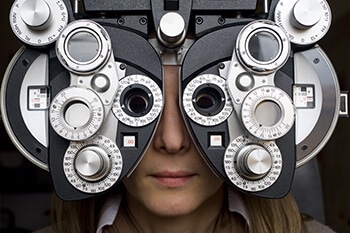What are Refractions?
 A refraction can be thought of as the part of the eye exam in which we determine your glasses prescription. A refraction is performed with a device called a phoropter and is part of most complete eye exams. Refractions are important because they are our first test to determine if correction of your vision requires “just glasses” or something more substantial like rigid contacts or surgery. We use refraction to bend the light entering the eye with lenses in an attempt to focus the light on your retina. For best results, this requires your attention and cooperation. Particularly in complex ocular conditions or following eye surgery, several refractions may be necessary for us to understand what is happening with your eye, even though a glasses prescription might not be given. In these situations, the refractions could be rapidly changing and giving the glasses prescription could lead to you getting glasses that are incorrect. Refraction is as much an art as a science and therefore you may experience different styles by different people. In one visit, you could be refracted two or even three times. It is even possible for more than one refraction (or glasses prescription) to be correct. Although we may miss a refraction on rare occasions, my office prides itself on our accuracy and attention to detail in our refractions.
A refraction can be thought of as the part of the eye exam in which we determine your glasses prescription. A refraction is performed with a device called a phoropter and is part of most complete eye exams. Refractions are important because they are our first test to determine if correction of your vision requires “just glasses” or something more substantial like rigid contacts or surgery. We use refraction to bend the light entering the eye with lenses in an attempt to focus the light on your retina. For best results, this requires your attention and cooperation. Particularly in complex ocular conditions or following eye surgery, several refractions may be necessary for us to understand what is happening with your eye, even though a glasses prescription might not be given. In these situations, the refractions could be rapidly changing and giving the glasses prescription could lead to you getting glasses that are incorrect. Refraction is as much an art as a science and therefore you may experience different styles by different people. In one visit, you could be refracted two or even three times. It is even possible for more than one refraction (or glasses prescription) to be correct. Although we may miss a refraction on rare occasions, my office prides itself on our accuracy and attention to detail in our refractions.
Many vision specific insurance plans pay for refractions. However, most medical insurance plans (including Medicare) do not pay for refractions. Because of this, if you are using your medical insurance, it is likely there will be a charge for your refraction that is separate from your co-pay or exam charge.

20/20 vision means the viewed image is in focus on the retina
We normally check vision at a distance of 20 feet. This is the first number in “20/20”. The second number is the distance at which someone with “perfect” vision could read that size lettering. Therefore, 20/60 means that the eye is able to see a particular size letter from 20 feet away that an eye with “perfect” vision could see from 60 feet away. Near vision is measured slightly differently. There are many other measurable aspects of vision such as depth perception, color perception, contrast sensitivity, metamorphopsia, and glare that can all affect how we feel about how well we see.
Here are some common benchmarks for visual acuity:
- 20/2: vision of some birds
- 20/15: one line better than “perfect” vision
- 20/20: “perfect” vision
- 20/25: vision needed to pilot a major airline
- 20/30: similar to a contact being out of position
- 20/40: roughly the vision needed to pass the Texas driver’s exam without glasses. Best corrected vision of 20/40 is the level that most people begin to have difficulty reading street signs and newspaper print.
- 20/50 to 20/70: roughly the corrected vision needed to pass the Texas driver’s exam with restrictions. Best corrected vision of 20/50 to 20/70 is when most patients begin to consider surgery to improve their vision. Patients whos best corrected vision cannot be improved to 20/70 or better, are not allowed to drive in Texas except in very special circumstances. This link shows the driving vision requirements for each state as of 2003:Driving vision requirements by state
- 20/60: best corrected vision of less than 20/60 is Medicare’s definition of moderate visual impairment
- 20/80: most people have stopped recreational reading by this point
- 20/100: similar to looking through wax paper
- 20/200: best corrected vision of 20/200 is the definition of legal blindness in the United States
- 20/400: best corrected vision of less than 20/400 is Medicare’s definition of profound visual impairment
- Count fingers: only able to count fingers held several feet in front of eyes
- Hand motion: only able to see the movement of an object several feet in from of eyes
- Light perception: only able to determine if light is entering the eye or not
- No light perception: total blindness with no ability to perceive light


